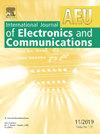Analysis of symbol error probability in GFDM under generalized α−κ−μ channels: An approach based on probability density function for beyond 5G wireless applications
IF 3.2
3区 计算机科学
Q2 ENGINEERING, ELECTRICAL & ELECTRONIC
Aeu-International Journal of Electronics and Communications
Pub Date : 2025-07-17
DOI:10.1016/j.aeue.2025.155946
引用次数: 0
Abstract
Generalized Frequency Division Multiplexing (GFDM) is a flexible multicarrier modulation scheme tailored to meet the diverse requirements of 5G and beyond (B5G) wireless systems. It provides flexibility to select subsymbols, subcarriers, and pulse-shaping filters, making it suitable for various B5G communication needs. Moreover, GFDM includes orthogonal frequency division multiplexing (OFDM) and single carrier frequency domain equalization (SC-FDE) as special cases. Since fading conditions greatly affect communication reliability, this paper derives a closed-form expression for the symbol error probability/symbol error rate (SEP/SER) of GFDM using M-QAM and M-PSK in generalized fading channels. The study examines how fading parameters (), pulse-shaping filters, roll-off factor, and subsymbol count influence SER performance. Results show these factors have a significant impact on error probability. This comprehensive analysis provides important insights for evaluating GFDM performance under complex fading scenarios, making it a valuable reference for GFDM system design for B5G wireless applications.
广义α−κ−μ信道下GFDM的符号错误概率分析:基于概率密度函数的超5G无线应用方法
通用频分复用(GFDM)是一种灵活的多载波调制方案,专为满足5G及以上(B5G)无线系统的各种需求而量身定制。它提供了选择子符号、子载波和脉冲整形滤波器的灵活性,使其适合各种B5G通信需求。此外,GFDM还包括正交频分复用(OFDM)和单载波频域均衡(SC-FDE)作为特例。由于衰落条件对通信可靠性的影响很大,本文推导了广义α−κ−μ衰落信道中使用M-QAM和M-PSK的GFDM的符号误码率/符号误码率(SEP/SER)的封闭表达式。研究考察了衰落参数(α、κ、μ)、脉冲整形滤波器、滚降因子和子符号计数对SER性能的影响。结果表明,这些因素对误差概率有显著影响。该综合分析为评估复杂衰落场景下GFDM的性能提供了重要见解,为B5G无线应用的GFDM系统设计提供了有价值的参考。
本文章由计算机程序翻译,如有差异,请以英文原文为准。
求助全文
约1分钟内获得全文
求助全文
来源期刊
CiteScore
6.90
自引率
18.80%
发文量
292
审稿时长
4.9 months
期刊介绍:
AEÜ is an international scientific journal which publishes both original works and invited tutorials. The journal''s scope covers all aspects of theory and design of circuits, systems and devices for electronics, signal processing, and communication, including:
signal and system theory, digital signal processing
network theory and circuit design
information theory, communication theory and techniques, modulation, source and channel coding
switching theory and techniques, communication protocols
optical communications
microwave theory and techniques, radar, sonar
antennas, wave propagation
AEÜ publishes full papers and letters with very short turn around time but a high standard review process. Review cycles are typically finished within twelve weeks by application of modern electronic communication facilities.

 求助内容:
求助内容: 应助结果提醒方式:
应助结果提醒方式:


